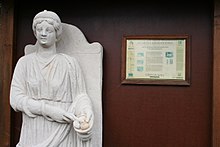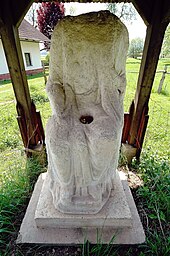Sirona (mythology)
Sirona , also Đirona , was a Celtic goddess of healing. Iconographically she was equated with the Roman goddess Hygieia . She is often a cult companion of Apollo Grannus .
General
Sirona is only known from inscriptions, no ancient written source mentions it, it has no mythology.
So far, nine dedicatory inscriptions are known for (Dea) Sirona alone. They can be found predominantly in the provinces of Gallia Belgica and Germania superior , occasionally in the provinces of Gallia Celtica , Aquitania and Lugdunensis .
More often, however, a total of fifteen times, it is mentioned in combination with Apollo , who was identified with the healing god Grannus in the course of the Interpretatio Romana . These inscriptions can be found in the Gallia Belgica and in the Germania superior, in Raetia , Noricum , Pannonia and Dacia as well as once in Rome , but not in western Gaul.
A sanctuary of Apollo and Sirona from the 2nd century AD was excavated in Hochscheid ( Hunsrück ). There was also the inscription “DEO APOLLINI ET SANCTE SIRONE”. Another sanctuary of Apollo and Sirona is documented by a building inscription from Grossbottwar dated 201 AD . Sirona was often worshiped at medicinal springs.
She was depicted as a young woman dressed in a palla , partly with a grape and ear of wheat as an attribute, partly - following the example of Hygieia - with a snake that she holds in her hands.

Surname
Her name means "lofty, big star" or "calf, heifer ". Helmut Birkhan prefers the latter translation because, following Garrett S. Olmsted, he associates it with the Indo-European word root * ster- (“not yet sexually mature cattle”).

In inscriptions there are other spellings in addition to Sirona : Đirona several times and Serana and Thirona once each . The different ways of writing the initial sound show the difficulty of reproducing it in the Latin alphabet. The Đ is called Tau Gallicum and is pronounced like a sharp, hissing ß , ss , z or ts , but also like st at the beginning of the word . Hence the goddess was probably pronounced Zirona .
Merging with Cybele?
In the Roman city of Iuvavum (today Salzburg ), Asklepios and Hygeia were evidently intensely venerated. In the surrounding area (today Bavaria) there was also a consecration to the healing god Apollo Grannus and the source goddess Sirona. Under certain circumstances, Grannus and Sirona were identified by Greek freedmen there with Asklepios and Hygeia. In addition to the Asklepios and Hygeia finds , Serapis and Cybele were also found in Salzburg , so that an equation can be assumed here as well.
However, there are many representations of Kybele in the entire Noric region , so that Sirona can possibly be thought of here.
For example, the headless seated statue of the so-called “Kuhdirn” by Wutschein (Magdalensberg municipality, Carinthia ) is to be thought of (the severed head is said to have been walled into the basement foundations of the farm in the southeast).
See also
- Sironabad (Roman baths) to Nierstein am Rhein
- (116) Sirona asteroid
literature
- Max Him : Sirona . In: Wilhelm Heinrich Roscher (Hrsg.): Detailed lexicon of Greek and Roman mythology . Volume 4, Leipzig 1915, Col. 952-957 ( digitized version ).
- Johann Baptist Keune : Sirona. In: Paulys Realencyclopadie der classischen Antiquity Science (RE). Volume III A, 1, Stuttgart 1927, Col. 354-360.
- Gerd Weisgerber : The pilgrim sanctuary of Apollo and Sirona from Hochscheid in the Hunsrück. Habelt, Bonn 1975.
- Árpád M. Nagy: Sirona . In: Lexicon Iconographicum Mythologiae Classicae (LIMC). Volume VII, Zurich / Munich 1994, pp. 779-781.
- Bernhard Maier : Lexicon of Celtic Religion and Culture (= Kröner's pocket edition . Volume 466). Kröner, Stuttgart 1994, ISBN 3-520-46601-5 , pp. 292-293.
- Helmut Birkhan : Celts. Attempt at a complete representation of their culture. Publishing house of the Austrian Academy of Sciences, Vienna 1997, ISBN 3-7001-2609-3 , pp. 590-591. 621-621.
- Bernhard Maier: The Celts. Your story from the beginning to the present. CH Beck, Munich 2000, ISBN 3-406-46094-1 , pp. 114-115.
- Marion Euskirchen: Sirona. In: The New Pauly (DNP). Volume 11, Metzler, Stuttgart 2001, ISBN 3-476-01481-9 , Sp. 596.
Web links
- Inscriptions for Sirona in the Heidelberg Epigraphic Database
- [1] Krüger, Emil: The interpretation of the Pforzheimer statuette as the goddess Sirona
- The Vienne-en-Val Museum
Individual evidence
- ↑ Bordeaux (Burdigala): CIL XIII, 582 Sironae / Adbucietus / Toceti fil (ius) / v (otum) s (olvit) l (ibens) m (erito) ; CIL XIII, 586 [Sir] onae (?) M (arcus) Sulpicius Primulus // Turiassone (n) sis seviral (is) d (e) s (ua) p (ecunia) f (aciendum) c (uravit) // Sulpicius Sacuro f (ilius) // Sulpicia Censorina f (ilia) // Sulpicia Phoebe l (iberta)
- ↑ z. B. Augusta Raurica : Herbert Nesselhauf , Hans Lieb: Third supplement to CIL XIII: Inscriptions from the Germanic provinces and the Trever area. In: Report of the Roman-Germanic Commission 40, 1959, p. 158 No. 97.
- ↑ Sarmizegetusa : AE 1957, 197 ; AE 1983, 828 .
- ↑ CIL VI, 36 : Apollini / Granno et / Sanctae / Sironae / sacrum .
- ↑ Gerd Weisgerber: The pilgrim sanctuary of Apollo and Sirona from Hochscheid in the Hunsrück. Habelt, Bonn 1975.
- ↑ AE 1941, 89 : Deo Apolli / ni et sanc / t (a) e Siron (a) e / r (eficiundum) c (uravit) per Con / [
- ↑ CIL XIII, 6458 ; Inscription at ubi-erat-lupa .
- ↑ From Stern: gall. ser , syr , kymr. sera , grain. steyr , steren , breton. ster , sterenn , altlat. sterra
- ↑ Helmut Birkhan: Kelten, attempt at an overall representation of their culture. Vienna 1997, pp. 590-591. 621.
-
↑ AE 1994, 1256 : Augusta Treverorum , Gallia Belgica Deae Diro [nae] / Silvin [i] / Adiutor et Iun [ianus] / v (otum) s (olverunt) l (ibentes) m (erito)
AE 1994, 1257 : ibid. De] ae Diro (nae) deo [Apollini?] / [3] AE II [3] / [3] v (otum) s (olvit) l (ibens) [m (erito)]
CIL XIII, 3662 : ibid. D (e) ae Dirona (e) / L (ucius) Lucanius Censor [i] / nu [s] sigillum d (onum) d (edit)
CIL XIII, 4498 : Saint-Avold / Mediomatrici , Gallia Belgica Deae Dironae / Maior Ma / giati filius / v (otum) s (olvit) l (ibens) m (erito)
CIL XIII, 3143 = AE 1999, 1071 : Corseul / Fanum Martis , Lugdunensis Num (ini) Aug (usti) de (ae ) / Dirona (e) Cani (a) / Magusia lib (erta) / v (otum) s (olvit) l (ibens) m (erito) - ↑ AE 1982, 806 : Aquincum , Pannonia inferior Apollini / et / Sironae / T (itus) Iul (ius) Mer / cator d (ecurio) c (oloniae) / v (otum) s (olvit) l (ibens) m ( erito)
- ↑ AE 1994, 1227 : from Milan / Mediolanum, Transpadana Thiron (a) et Apollo


